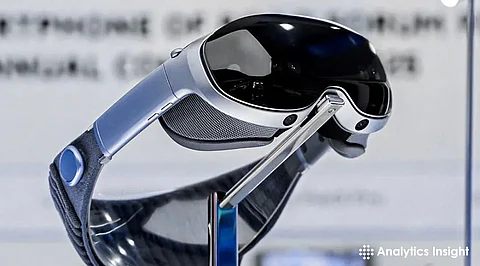

Vivo, the Chinese smartphone brand known for its camera-focused devices and sleek design language, has now taken a leap into mixed reality (MR). At the Boao Forum for Asia Annual Conference 2025, the company unveiled its upcoming headset, called Vivo Vision. The prototype marks Vivo's entry into the world of spatial computing a growing tech trend that blends real and digital environments through advanced headsets.
The Vivo Vision bears a strong resemblance to Apple’s Vision Pro, which was announced in 2023 and hit stores in 2024. From the design to the features, the similarities are sparking a lot of chatter in the tech world.
Early images of the Vivo Vision headset show a ski goggle-like design, with a glossy visor and sleek frame. It includes two visible sensors placed at the bottom of the headset, which likely enable hand and finger gesture tracking—something Apple introduced with the Vision Pro. The headband also looks familiar, built for comfort and balance during long periods of use.
The design and layout are suggestive that Vivo is going for that premium feel and look without sacrificing pragmatism. Whether or not this is due to collaborative design thinking or a blatant homage to Apple remains to be seen.
Vivo hasn’t shared full specifications yet, so there’s no confirmed word on what kind of chipset powers the headset, the display resolution, or the software it will run on. There’s also no clarity on whether this will be a standalone device like Meta’s Quest or if it will need to connect to a phone or PC.
But the Vivo Vision is part of the company's larger Blue Technology Matrix—a initiative aimed at applying artificial intelligence to real-world, real-life situations. That is, the headset will presumably enable both virtual reality (VR) and augmented reality (AR), and will make extensive use of spatial computing to provide more natural and interactive experiences.
The firm anticipates it will demonstrate a functional prototype of Vivo Vision around mid-2025. Public demonstrations can then follow. Further details on the operating system, features, and cost are anticipated to be revealed over the next few months.
For now, the headset is still a prototype with a lot of intrigue surrounding it. But Vivo's aggressive push into mixed reality indicates how quickly this sector is expanding and how much more tech brands want to take on Apple and Meta.
As an added teaser, Vivo also previewed its future flagship phone, the Vivo X200 Ultra, at the same event. Though there are few details, the phone will likely have a close relationship with the Vivo Vision headset—just as Apple's iPhone does with Vision Pro.
Vivo’s new headset looks and feels a lot like Apple’s Vision Pro, and that’s not a coincidence. The company seems to be taking cues from Apple’s approach while trying to create a more accessible alternative for the wider market. It’s still too early to tell how well it will perform or whether it can match Apple’s ecosystem, but one thing is clear: the mixed reality race is heating up fast, and Vivo is ready to play.
